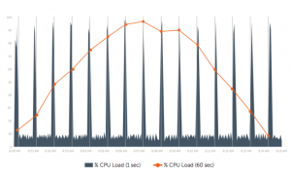Four things we bet your APM tool can’t do (but needs to!)
Applications sit at the center of today’s digital businesses. As consumers, we interact with our favorite brands primarily through apps—hailing cabs, doing our finances, and most (if not all) of our holiday shopping. And, of course, our jobs are equally app-centric.
There really is an app for almost everything. And so it logically follows that businesses are seeking better, faster ways to build, deploy, and support their most critical applications. That’s partially what’s paved the ways for things like DevOps and cloud-native technologies such as microservices and containers.
Of course, if apps are slow or offer a subpar user experience, then businesses run the risk of losing customers and employees. To ensure application health and availability, companies have historically leveraged application performance monitoring (APM) tools. However, widespread adoption of cloud—including SaaS and the aforementioned cloud-native components—is pushing traditional APM tools and monitoring strategies beyond the breaking point.
Here are four things we bet your current APM tool can’t do, but absolutely needs to, to support today’s digital business.
1. Your APM tool can’t hold SaaS vendors accountable for SLAs

SaaS adoption by the numbers
SaaS represents a seismic shift in how companies are consuming applications. In fact, SaaS is the largest growth segment in terms of enterprise cloud spending. Given this, ensuring SaaS apps perform well is critical for improving workplace productivity and other business metrics.
However, SaaS applications are largely outside of corporate IT’s direct control, as the vendors manage the hosting infrastructure. This can make it difficult for IT to ensure these apps perform consistently, as they can’t instrument the back-end with traditional monitoring agents.
Most APM tools claim to do some form of end-user experience monitoring. But most fall short of capturing what the user ACTUALLY experiences as the app loads on their device screens. And while SaaS vendors offer SLAs for uptime and availability, those guarantees end at the edge of their infrastructure. Left with few other options, IT teams are often forced into reactive mode, waiting for users to report performance problems.
2. Your APM tool can’t scale with the volume and velocity of digital business
Today’s cloud-native application environments are orders of magnitude more complex than their monolithic counterparts. Coupled with high rates of change spurred by DevOps and other agile methodologies, this app complexity increases the risk of unstable releases and poor experiences for end users.
These applications are also generating far more data. In fact, containerized apps create 18x more data than legacy apps. Unfortunately, traditional APM tools sacrifice granularity of data for scale, taking a sampling or snapshot-based approach that only captures partial data for a subset of transactions.
Data incompleteness creates blind spots for troubleshooters when they are desperately trying to track down the cause of a performance issue. And this is simply not going to cut it when revenue and productivity are at stake in highly competitive markets where every second counts.
3. Your APM tool can’t detect micro-contentions in containerized apps
Similar to the problem of scale is the inability to troubleshoot what are highly dynamic application environments. The cloud gives developers on-demand access to more computing power, and its elasticity is promising for workloads that have periods of peak usage (like e-commerce sites over the holidays).
But this elasticity becomes challenging for application teams when one considers the short-lived nature of certain application processes, particularly when those processes require simultaneous access to finite computing resources (e.g., CPU, memory). These resulting micro-contentions can cause intermittently slow transaction performance.
Without high-definition monitoring, such micro-contentions are nearly impossible to detect. For instance, coarse monitoring at 1-minute intervals will completely miss short-lived problems, or potentially alert teams to false conclusions.

Coarse monitoring at 1-minute intervals (represented in orange) completely misses the spikes in the data, alerting teams to false conclusions about performance issues.
4. Your APM tool can’t deliver high-quality data for AIOps and machine learning
AIOps, when combined with APM, helps troubleshooters act swiftly by proactively surfacing problems before they become actual performance events. But to unlock the true power of AIOps, teams need high-quality data.
Unfortunately, as we know, most APM tools can’t scale in environments that generate billions of transactions on a daily basis. User metadata—for example, the content of an online shopping cart—is frequently discarded, but is critical for analysis. As a result, 71% of organizations report that their performance data isn’t actionable.
Modern APM tools must provide high-quality data to support AIOps initiatives and also deliver the analytics that enable teams to extract the right insights from what is otherwise petabytes of raw performance data.
 By Gayle Levin
By Gayle Levin
Published with permission from Riverbed.